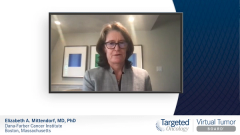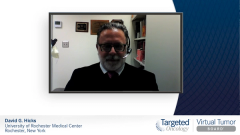
Case 1: KEYNOTE-355 Trial Design and Considerations
The panel of experts review the study design and key efficacy data of the KEYNOTE-355 trial.
Episodes in this series

Elizabeth A. Mittendorf, MD, PhD: The next slide we have related to this case is the schema for the KEYNOTE-355 study. As I alluded to, it looks a lot like the IMpassion130 trial in that it’s a study looking at the use of immunotherapy in metastatic triple-negative breast cancer. Here, the randomization is to receive either pembrolizumab plus chemotherapy or placebo. This is a trial evaluating Merck [& Co, Inc]’s compound Keytruda. One thing that’s a bit different in this trial is that different chemotherapeutic agents are used. If we look at the next slide, this trial shows that there is a benefit with respect to progression-free survival when you add immunotherapy to the chemotherapy, and it appears to be in the patients who have PD-L1–positive tumors. On this slide, you see that CPS [combined positive score], what David was just referring to, about how the 22C3 antibody is interpreted with respect to the status. Ruta, what are your thoughts about the difference in the 2 trial designs with respect to being able to use different chemotherapeutic agents? How does that help you think about which agent to use?
Ruta Rao, MD: I think one of the biggest differences, for me, is that the pembrolizumab trial allows you to use a gem carbo [gemcitabine, carboplatin] backbone as your chemotherapy. This patient we’re talking about specifically looks like she recurred 18 months after her original diagnosis, so she’s probably at least 12 months or more out from her neoadjuvant taxane. Unfortunately, sometimes we get these women who recur in less than 12 months from their neoadjuvant taxane therapy or they have significant residual neuropathy, so you’re hesitant to give them nab-paclitaxel or even paclitaxel again. I think having an immunotherapy combination without a taxane is a nice option for some of those patients.
Elizabeth A. Mittendorf, MD, PhD: What’syour opinion about using the 22C3 versus the SP142 antibody? What are you guys doing in Chicago?
Ruta Rao, MD: Like David said, sometimes we ask for both. It depends on which immunotherapy drug we’re planning to use, and which combination we’re planning to give. We’ll typically ask for the one that goes along with that. I haven’t seen it specifically yet, but I think what we are hesitant about is that to approve the drug combination, the insurance companies want to see the companion diagnostic being positive. So, if you want to use pembrolizumab, you’re going to have to show that the 22C3 is positive versus if you want to use atezolizumab, the SP142.
Elizabeth A. Mittendorf, MD, PhD: You said the word neuropathy, which I understand was in reference to the taxane toxicity, but these immunotherapeutic agents can have some toxicity as well. What sort of routine instructions do you give your patients to look out for regarding symptoms? How is this different than how you counsel them for similar symptoms when they’re on only chemotherapy? Are there any adverse effects that you’re routinely monitoring for with some sort of laboratory evaluation or other?
Ruta Rao, MD: Sure. We know that they’re all associated with all these different “itises” and that’s thyroiditis, hepatitis, colitis, and pneumonitis. This is something that as breast cancer medical oncologists, we’re the last ones to the party. All of our other medical oncology colleagues are very familiar with using immunotherapy and with how to manage the adverse effects. Especially in the first few patients I put on these regimens, I would do curbside consults with my other medical oncology colleagues who treat lung cancer or melanoma to know how to manage adverse effects. In terms of routine labs, I think we’re checking CBC [complete blood count] and CMP [comprehensive metabolic panel], but in addition to that, we’re checking troponins and thyroid functions as well. We do have to counsel the patients to look out for these different arrays of adverse effects. The good thing is that the incidence of these adverse effects is rare. In the breast cancer trials, the incidence of the adverse effects was not necessarily any different than we have seen in other clinical trials. I think the drugs showed similar adverse effect profiles.
Elizabeth A. Mittendorf, MD, PhD: Being a busy breast medical oncologist, and speaking to your own experience, I’m presuming you’ve developed a fair comfort level now with using these agents. What was that learning curve like?
Ruta Rao, MD: Whenever you use a new drug for the first time, it’s exciting, but then also a little anxiety-provoking. Especially when you’ve read that some of these adverse effects can cause these patients to be hospitalized. As breast medical oncologists, the majority of our patients are treated in the outpatient setting. We don’t have a lot of people getting really sick either from the disease or the adverse effects of therapy. We have them once in a while, but generally not as many hospitalized patients as some of our colleagues treating other tumor types. I think, again, it’s something we were able to learn about from our colleagues, and then these clinical trials, both the IMpassion and the KEYNOTE trials, showed us the incidence of these adverse effects.
Transcript edited for clarity.












































